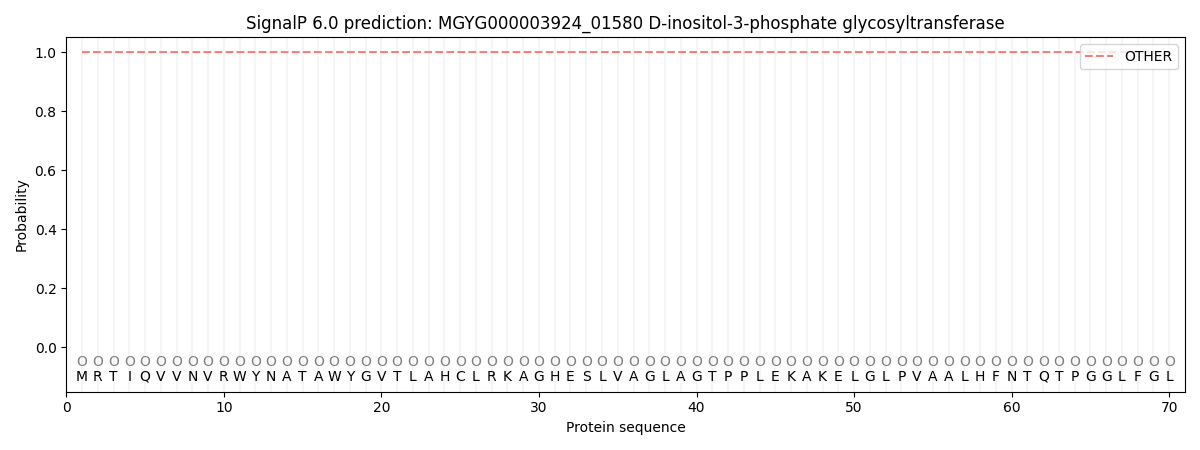You are browsing environment: HUMAN GUT
CAZyme Information: MGYG000003924_01580
You are here: Home > Sequence: MGYG000003924_01580
Basic Information |
Genomic context |
Full Sequence |
Enzyme annotations |
CAZy signature domains |
CDD domains |
CAZyme hits |
PDB hits |
Swiss-Prot hits |
SignalP and Lipop annotations |
TMHMM annotations
Basic Information help
| Species | Mailhella sp900555975 | |||||||||||
|---|---|---|---|---|---|---|---|---|---|---|---|---|
| Lineage | Bacteria; Desulfobacterota; Desulfovibrionia; Desulfovibrionales; Desulfovibrionaceae; Mailhella; Mailhella sp900555975 | |||||||||||
| CAZyme ID | MGYG000003924_01580 | |||||||||||
| CAZy Family | GT4 | |||||||||||
| CAZyme Description | D-inositol-3-phosphate glycosyltransferase | |||||||||||
| CAZyme Property |
|
|||||||||||
| Genome Property |
|
|||||||||||
| Gene Location | Start: 2592; End: 3737 Strand: + | |||||||||||
CDD Domains download full data without filtering help
| Cdd ID | Domain | E-Value | qStart | qEnd | sStart | sEnd | Domain Description |
|---|---|---|---|---|---|---|---|
| cd03801 | GT4_PimA-like | 2.49e-33 | 18 | 368 | 19 | 366 | phosphatidyl-myo-inositol mannosyltransferase. This family is most closely related to the GT4 family of glycosyltransferases and named after PimA in Propionibacterium freudenreichii, which is involved in the biosynthesis of phosphatidyl-myo-inositol mannosides (PIM) which are early precursors in the biosynthesis of lipomannans (LM) and lipoarabinomannans (LAM), and catalyzes the addition of a mannosyl residue from GDP-D-mannose (GDP-Man) to the position 2 of the carrier lipid phosphatidyl-myo-inositol (PI) to generate a phosphatidyl-myo-inositol bearing an alpha-1,2-linked mannose residue (PIM1). Glycosyltransferases catalyze the transfer of sugar moieties from activated donor molecules to specific acceptor molecules, forming glycosidic bonds. The acceptor molecule can be a lipid, a protein, a heterocyclic compound, or another carbohydrate residue. This group of glycosyltransferases is most closely related to the previously defined glycosyltransferase family 1 (GT1). The members of this family may transfer UDP, ADP, GDP, or CMP linked sugars. The diverse enzymatic activities among members of this family reflect a wide range of biological functions. The protein structure available for this family has the GTB topology, one of the two protein topologies observed for nucleotide-sugar-dependent glycosyltransferases. GTB proteins have distinct N- and C- terminal domains each containing a typical Rossmann fold. The two domains have high structural homology despite minimal sequence homology. The large cleft that separates the two domains includes the catalytic center and permits a high degree of flexibility. The members of this family are found mainly in certain bacteria and archaea. |
| cd03807 | GT4_WbnK-like | 7.19e-23 | 20 | 371 | 19 | 361 | Shigella dysenteriae WbnK and similar proteins. This family is most closely related to the GT4 family of glycosyltransferases. WbnK in Shigella dysenteriae has been shown to be involved in the type 7 O-antigen biosynthesis. |
| cd03819 | GT4_WavL-like | 4.66e-22 | 18 | 343 | 16 | 329 | Vibrio cholerae WavL and similar sequences. This family is most closely related to the GT4 family of glycosyltransferases. WavL in Vibrio cholerae has been shown to be involved in the biosynthesis of the lipopolysaccharide core. |
| TIGR03088 | stp2 | 8.43e-20 | 51 | 340 | 53 | 344 | sugar transferase, PEP-CTERM/EpsH1 system associated. Members of this family include a match to the pfam00534 Glycosyl transferases group 1 domain. Nearly all are found in species that encode the PEP-CTERM/exosortase system predicted to act in protein sorting in a number of Gram-negative bacteria. In particular, these transferases are found proximal to a particular variant of exosortase, EpsH1, which appears to travel with a conserved group of genes summarized by Genome Property GenProp0652. The nature of the sugar transferase reaction catalyzed by members of this clade is unknown and may conceivably be variable with respect to substrate by species, but we hypothesize a conserved substrate. |
| COG0438 | RfaB | 1.93e-19 | 110 | 371 | 129 | 378 | Glycosyltransferase involved in cell wall bisynthesis [Cell wall/membrane/envelope biogenesis]. |
CAZyme Hits help
| Hit ID | E-Value | Query Start | Query End | Hit Start | Hit End |
|---|---|---|---|---|---|
| ADP86584.1 | 3.38e-112 | 1 | 378 | 16 | 387 |
| ABM28304.1 | 3.38e-112 | 1 | 378 | 16 | 387 |
| ABB38453.1 | 4.78e-109 | 1 | 368 | 1 | 364 |
| AAS96355.1 | 1.77e-106 | 9 | 378 | 1 | 364 |
| ACU88358.1 | 5.72e-105 | 1 | 371 | 1 | 366 |
Swiss-Prot Hits download full data without filtering help
| Hit ID | E-Value | Query Start | Query End | Hit Start | Hit End | Description |
|---|---|---|---|---|---|---|
| D5USX8 | 8.52e-07 | 104 | 305 | 146 | 349 | D-inositol 3-phosphate glycosyltransferase OS=Tsukamurella paurometabola (strain ATCC 8368 / DSM 20162 / CCUG 35730 / CIP 100753 / JCM 10117 / KCTC 9821 / NBRC 16120 / NCIMB 702349 / NCTC 13040) OX=521096 GN=mshA PE=3 SV=1 |
| D3Q051 | 1.52e-06 | 132 | 305 | 187 | 360 | D-inositol 3-phosphate glycosyltransferase OS=Stackebrandtia nassauensis (strain DSM 44728 / CIP 108903 / NRRL B-16338 / NBRC 102104 / LLR-40K-21) OX=446470 GN=mshA PE=3 SV=1 |
SignalP and Lipop Annotations help
This protein is predicted as OTHER

| Other | SP_Sec_SPI | LIPO_Sec_SPII | TAT_Tat_SPI | TATLIP_Sec_SPII | PILIN_Sec_SPIII |
|---|---|---|---|---|---|
| 1.000025 | 0.000000 | 0.000000 | 0.000000 | 0.000000 | 0.000000 |
